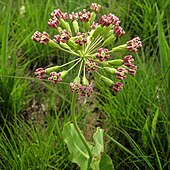
In botany, a pedicel is a stem that attaches a single flower to the inflorescence. Such inflorescences are described as pedicellate.
Description
Pedicel refers to a structure connecting a single flower to its inflorescence. In the absence of a pedicel, the flowers are described as sessile. Pedicel is also applied to the stem of the infructescence. The word "pedicel" is derived from the Latin pediculus, meaning "little foot". The stem or branch from the main stem of the inflorescence that holds a group of pedicels is called a peduncle. A pedicel may be associated with a bract or bracts.
In cultivation
In Halloween types of pumpkin or squash plants, the shape of the pedicel has received particular attention because plant breeders are trying to optimize the size and shape of the pedicel for the best "lid" for a "jack-o'-lantern".

Gallery
-
 Long pedicels of clasping milkweed with a single peduncle
Long pedicels of clasping milkweed with a single peduncle
-
 Cherry pedicels in flower and fruit
Cherry pedicels in flower and fruit
-
 Pumpkin pedicel
Pumpkin pedicel
See also
References
- Hickey, M.; King, C. (2001). The Cambridge Illustrated Glossary of Botanical Terms. Cambridge University Press.
- Walter William Skeat (1898). An Etymological Dictionary of the English Language (3 ed.). Clarendon Press. p. 430. ISBN 978-0-19-863104-0.
- Chris Bird, ed. (2014). The Fundamentals of Horticulture: Theory and Practice. Cambridge University Press. p. 136. ISBN 9781107782549.
- EB 2019.
- Breeding a better pumpkin - Technology & science - Science | NBC News
Bibliography
- Pedicel: Plant part. Encyclopædia Britannica. Retrieved 30 June 2019.
| Botany | |||||||||||
|---|---|---|---|---|---|---|---|---|---|---|---|
| Subdisciplines | |||||||||||
| Plant groups | |||||||||||
| Plant anatomy |
| ||||||||||
| Plant physiology Materials | |||||||||||
| Plant growth and habit | |||||||||||
| Reproduction | |||||||||||
| Plant taxonomy | |||||||||||
| Practice | |||||||||||
| |||||||||||
This plant morphology article is a stub. You can help Misplaced Pages by expanding it. |